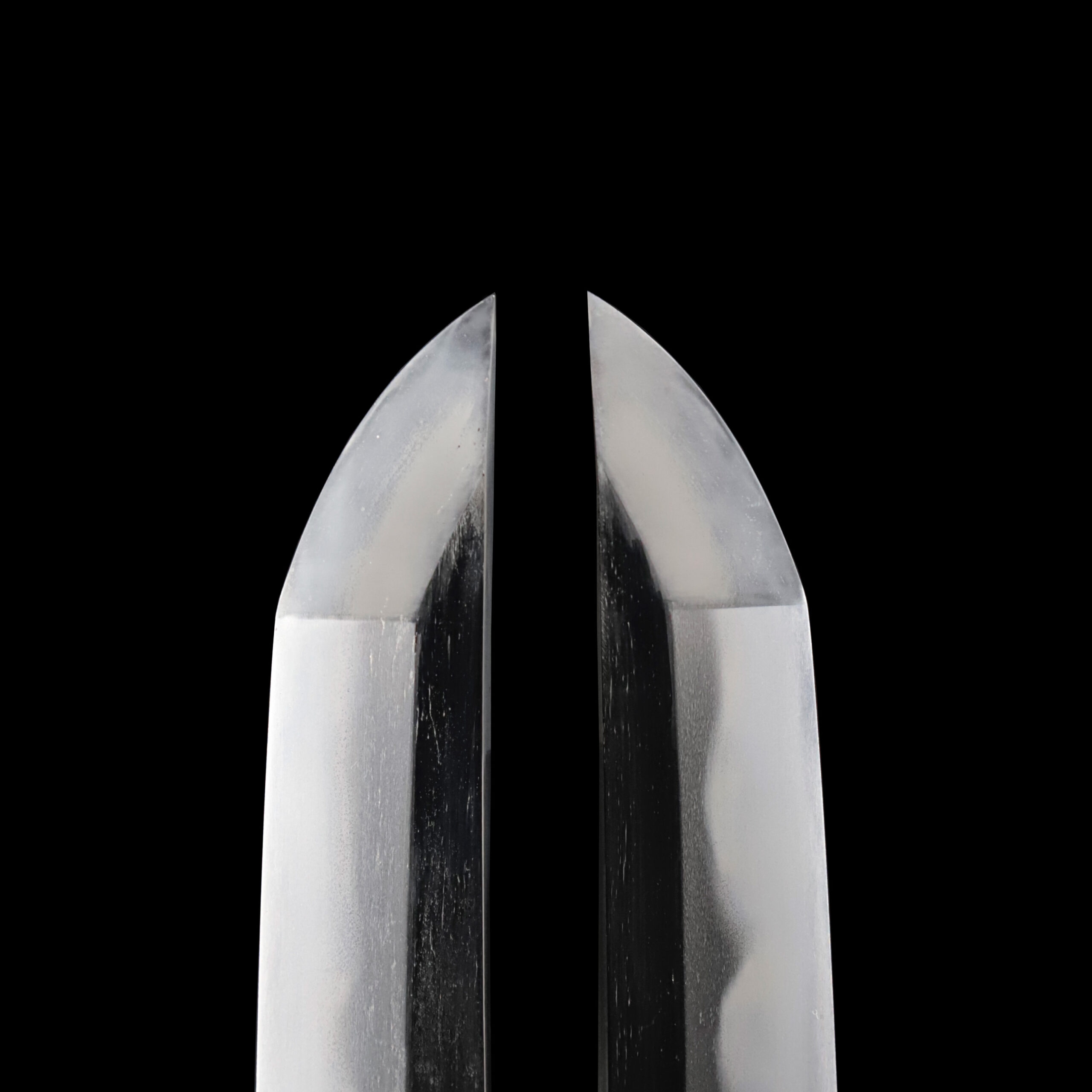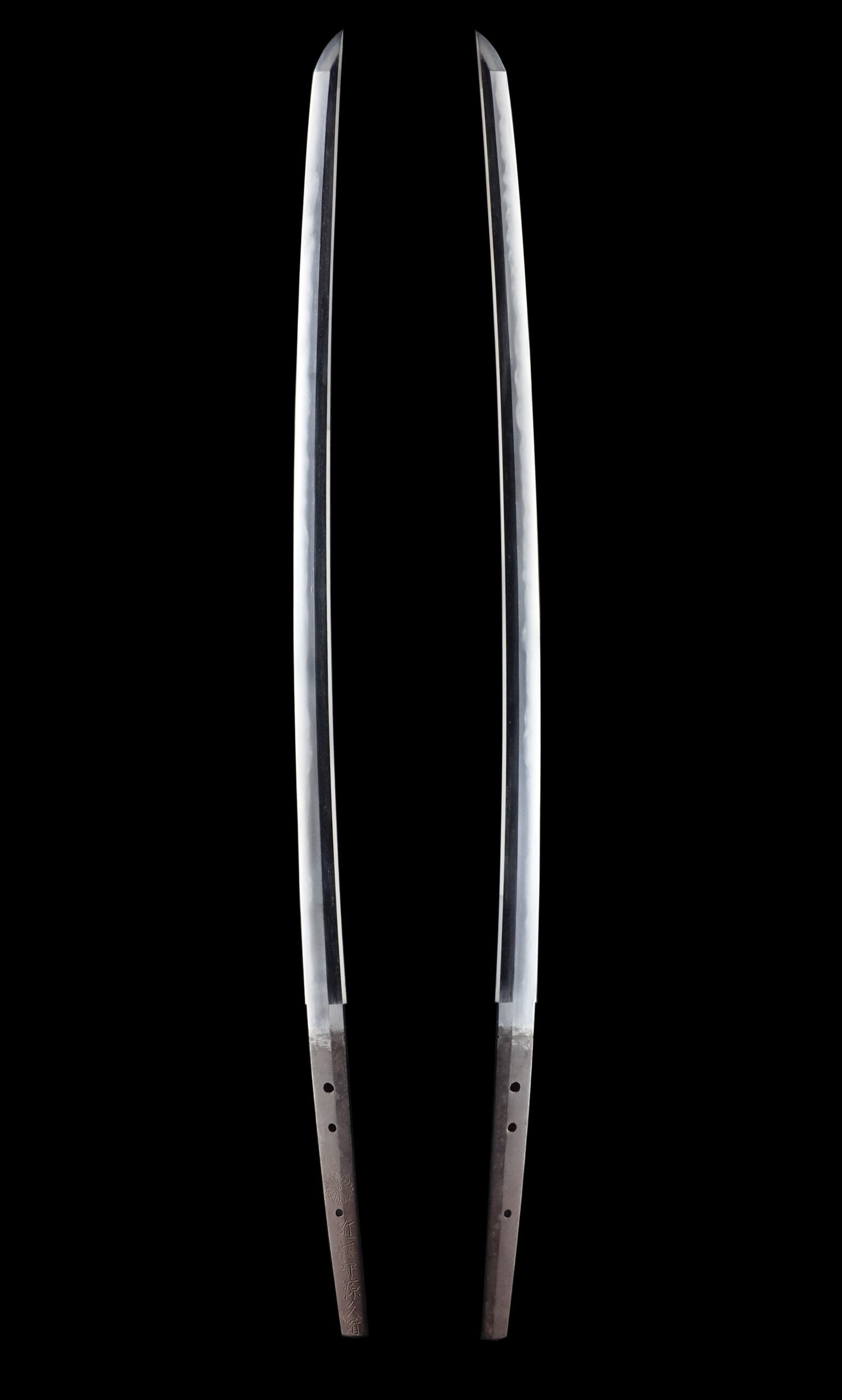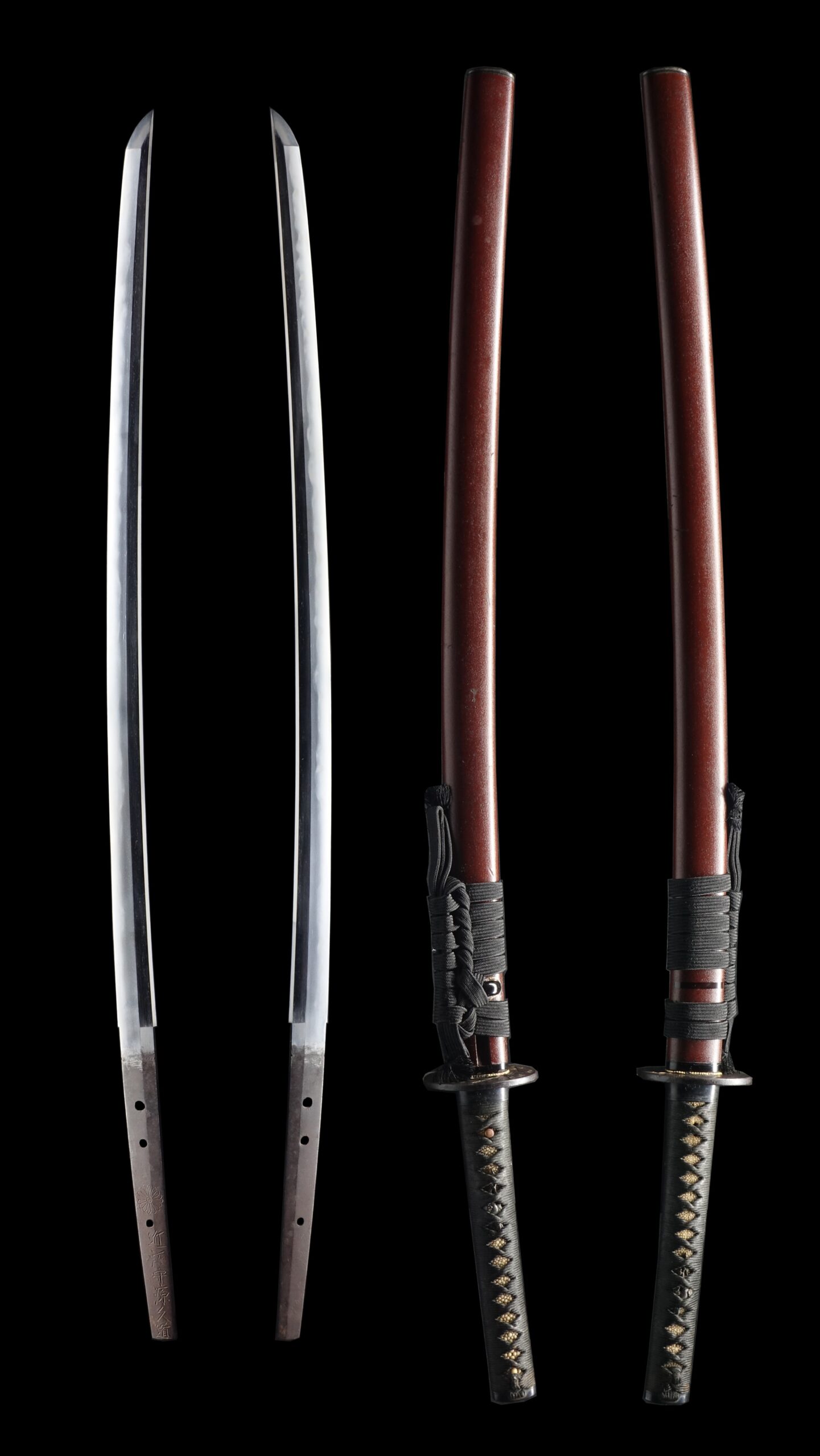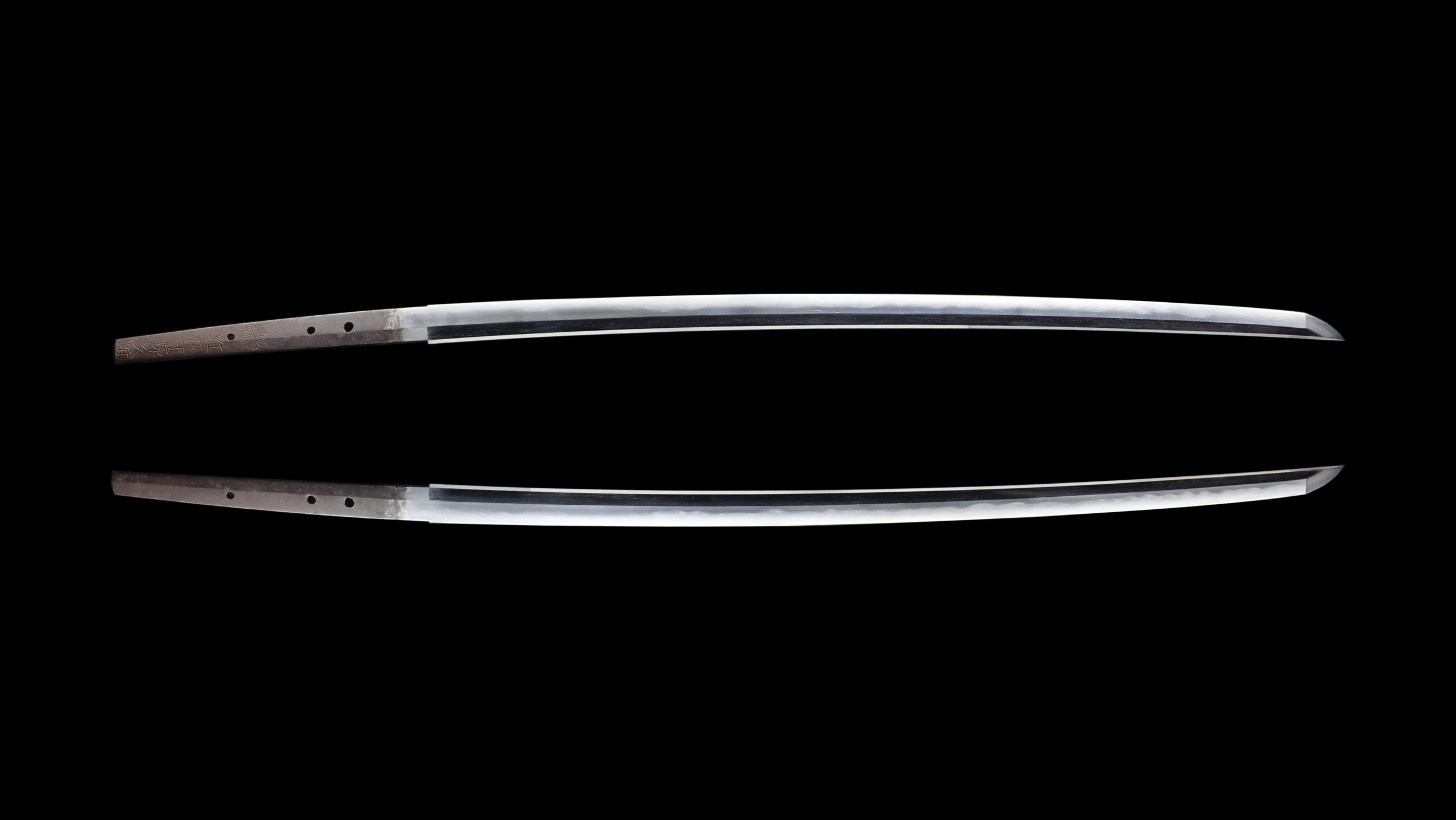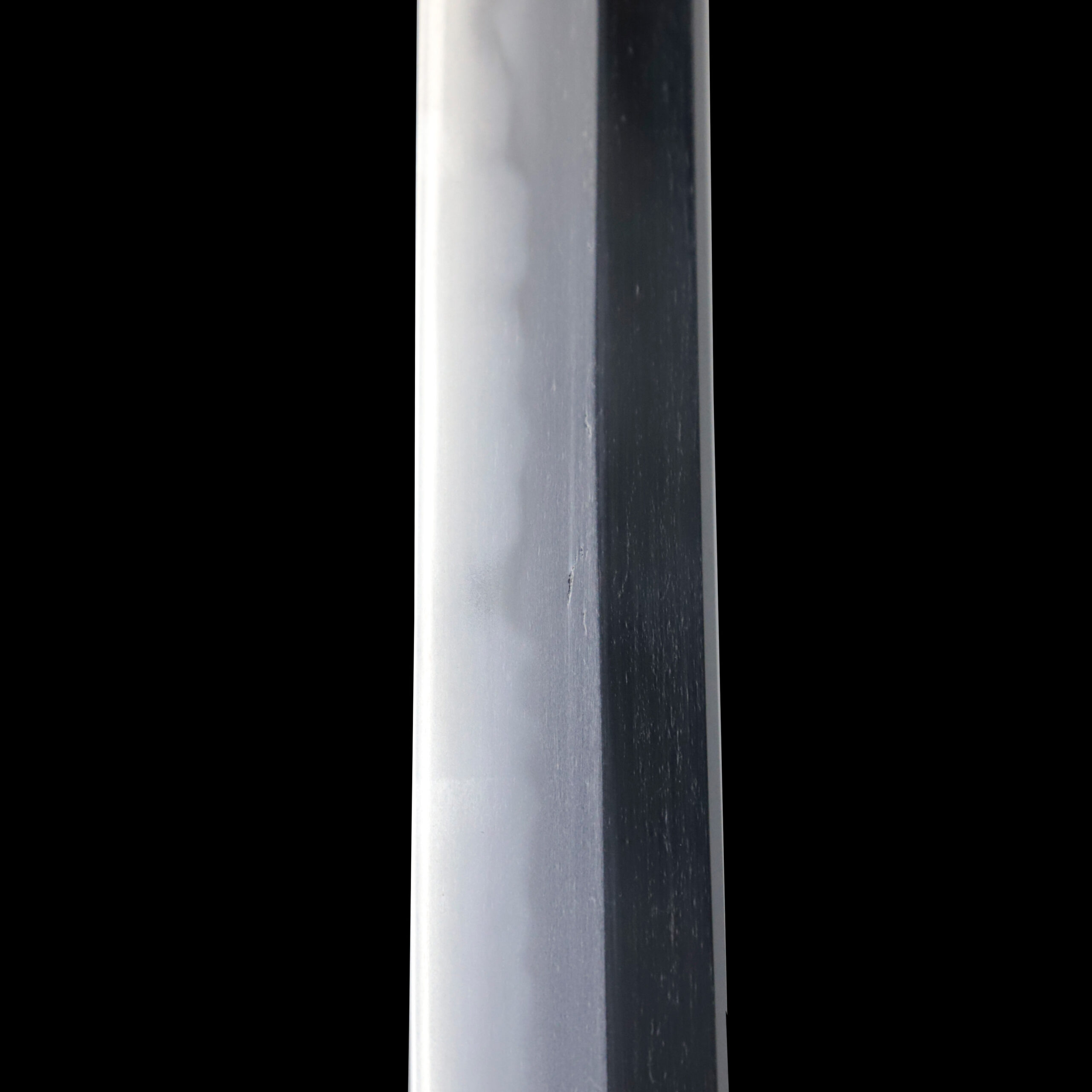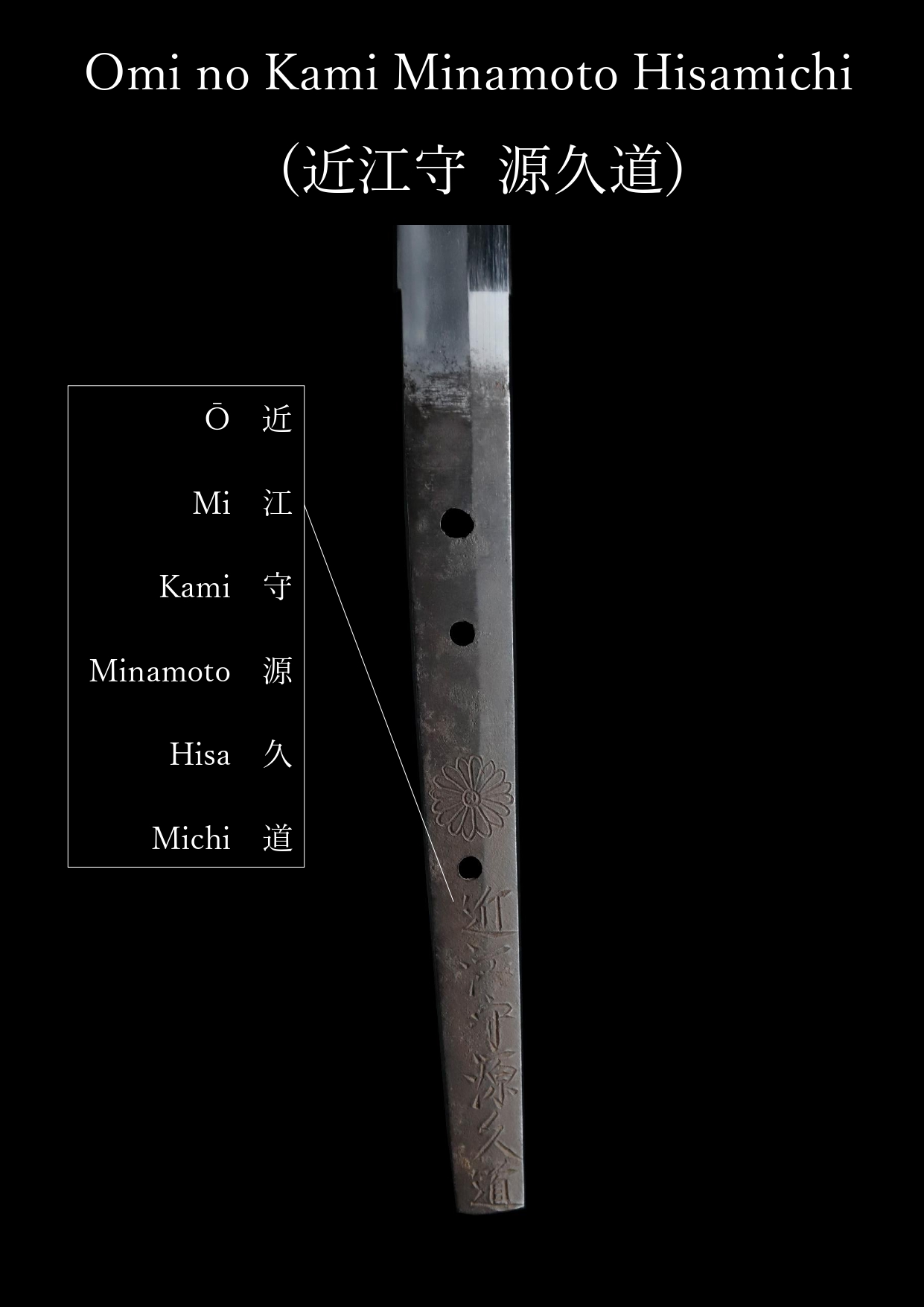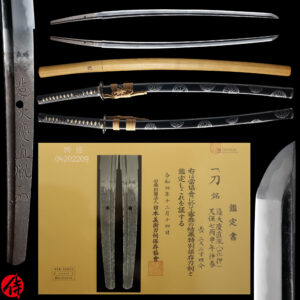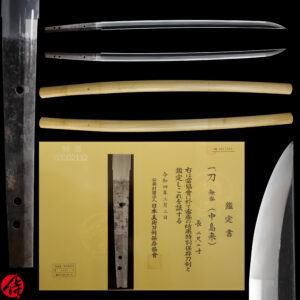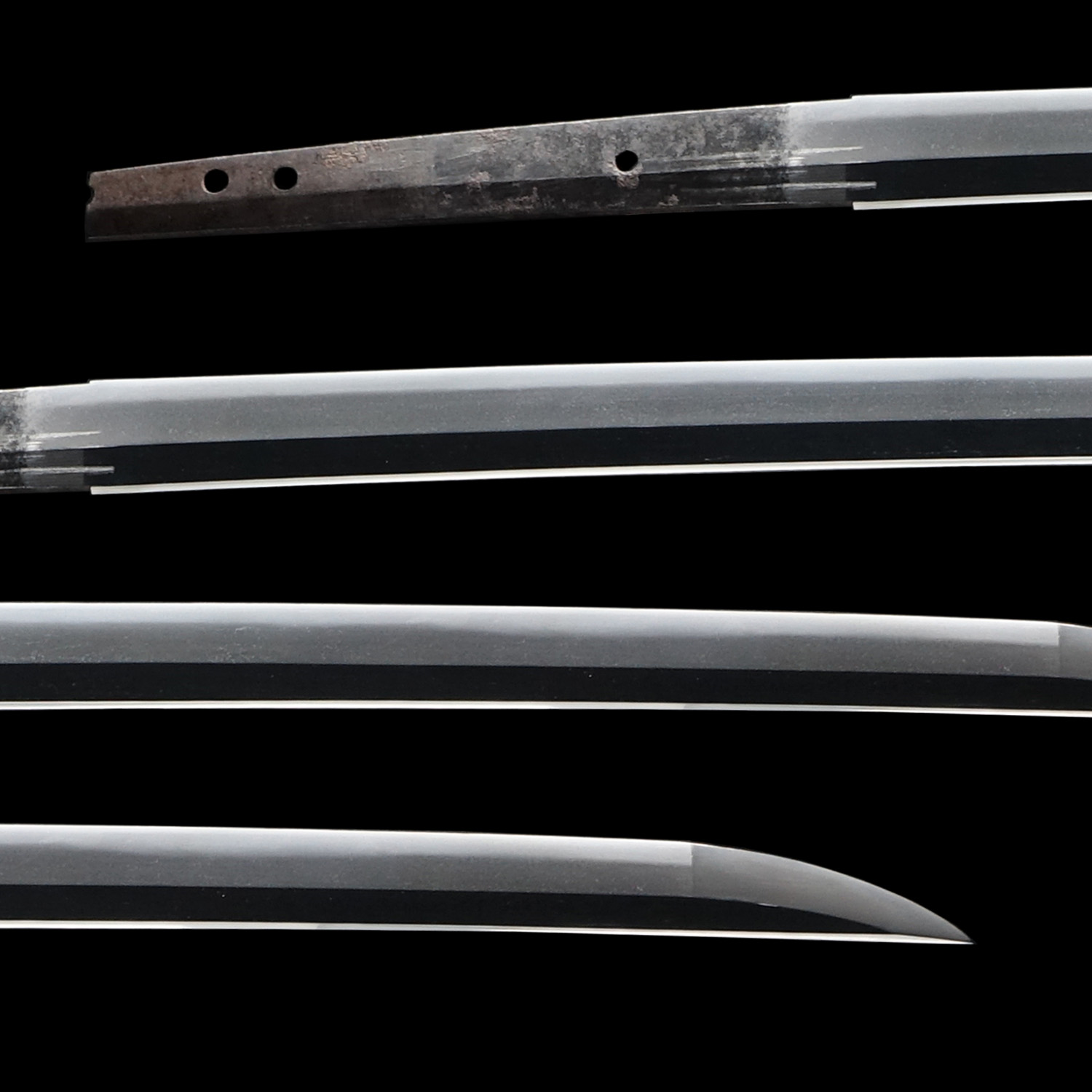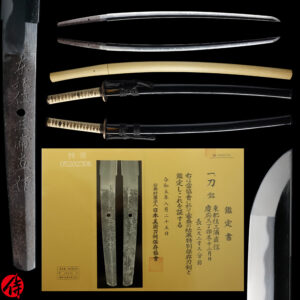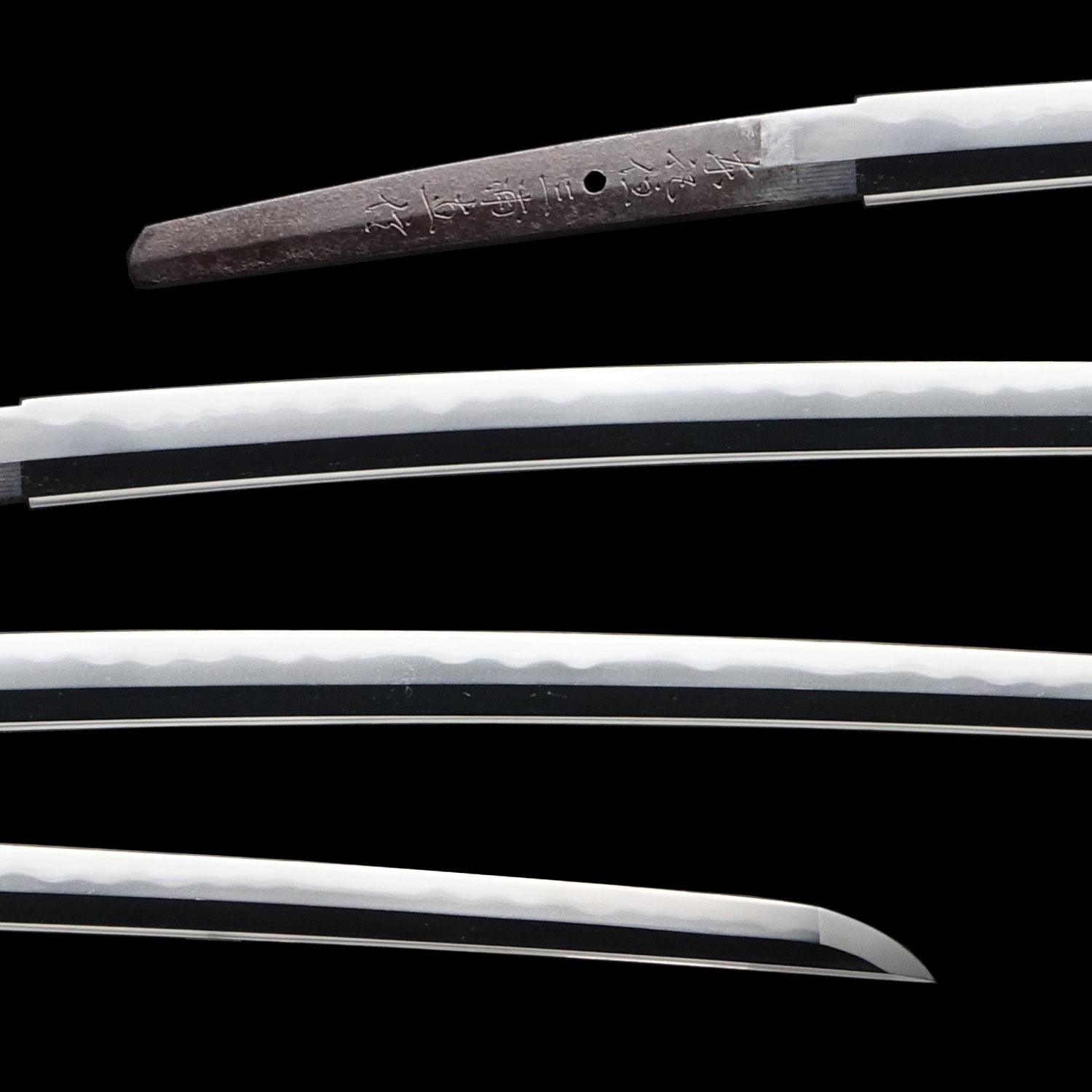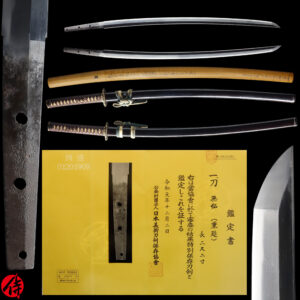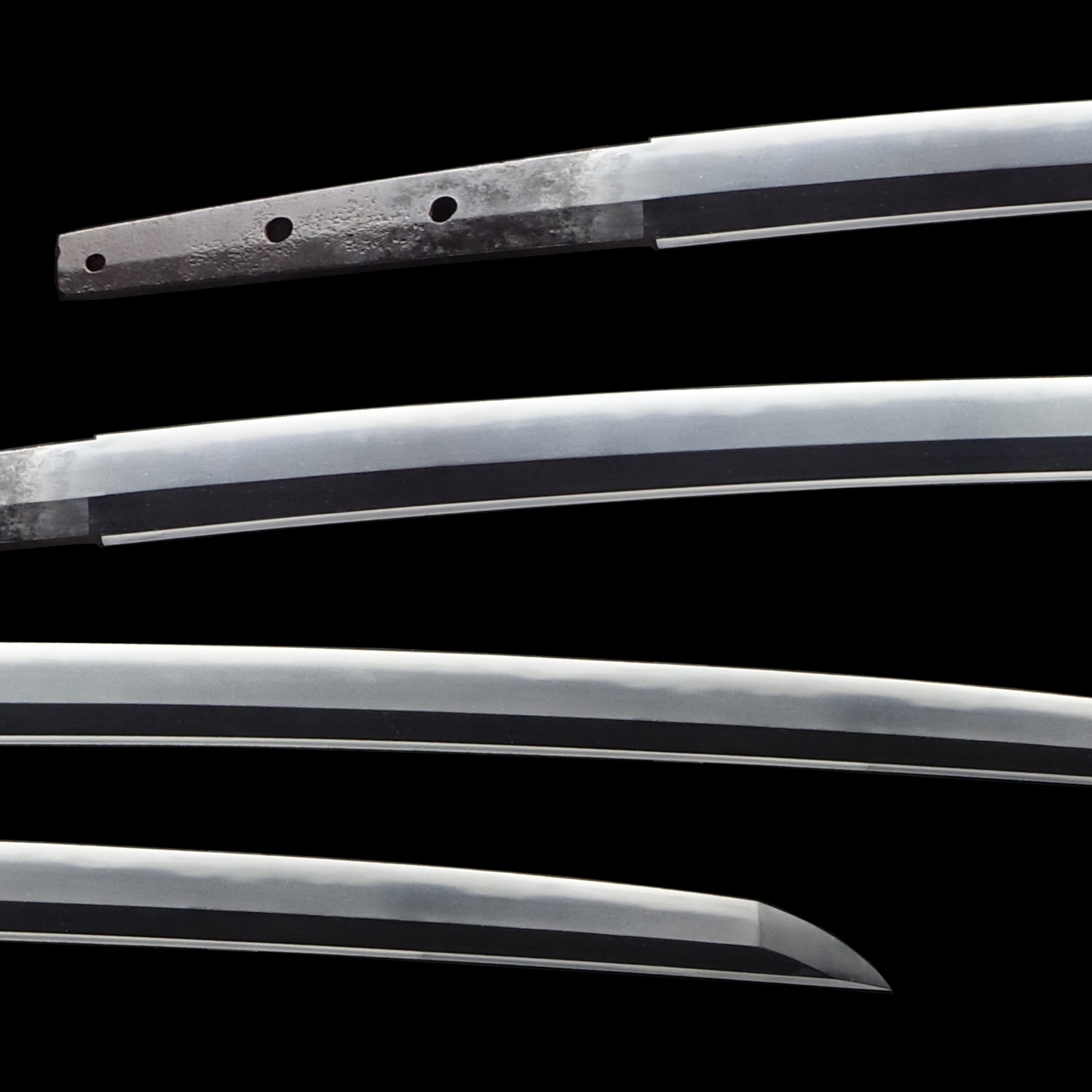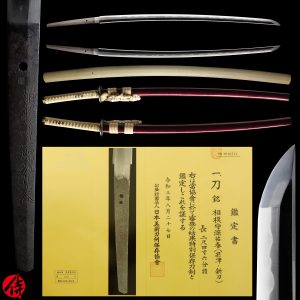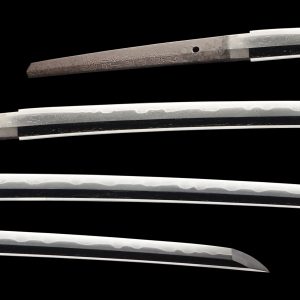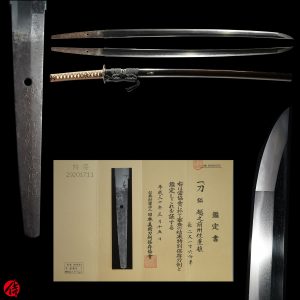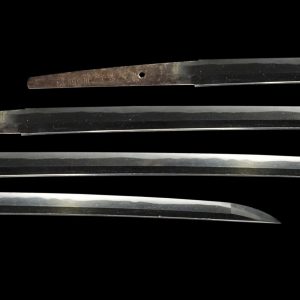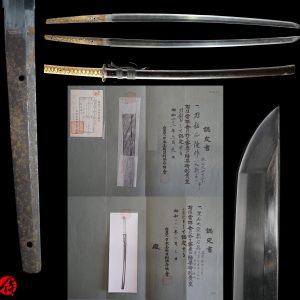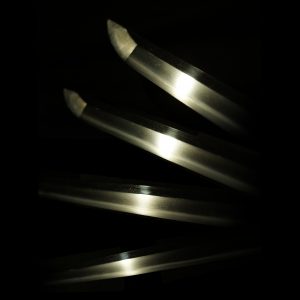Antique Japanese Sword Katana Signed by Omi no Kami Hisamichi with NBTHK Hozon Certificate
【Description】
This blade was signed by Omi no Kami Minamoto Hisamichi (近江守源久道). Judging from the signature, we believed the first-gen Hisamichi forged it. The swordsmith’s name Hisamichi lasted seventh generations. The first generation was active in sword-forging during the Keian-Kanbun era (1650-1673: Early Edo Period).
Hisamichi was born in the second year of the Kan-Ei era (1625) in Omi province (Shiga prefecture). He belonged to Mishina school, a prestigious school in Yamashiro province(today’s Kyoto prefecture). He studied sword forging techniques under the master, the second-gen Iganokami Kinmichi (伊賀守金道), one of the most famous swordsmiths in Yamashiro province during the early Edo period.
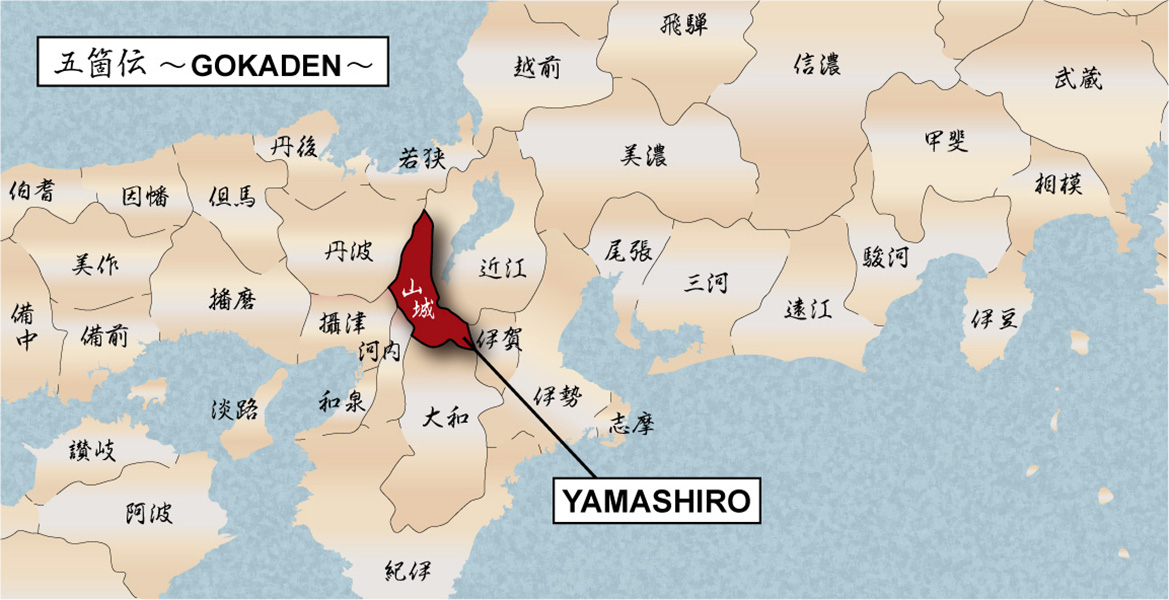
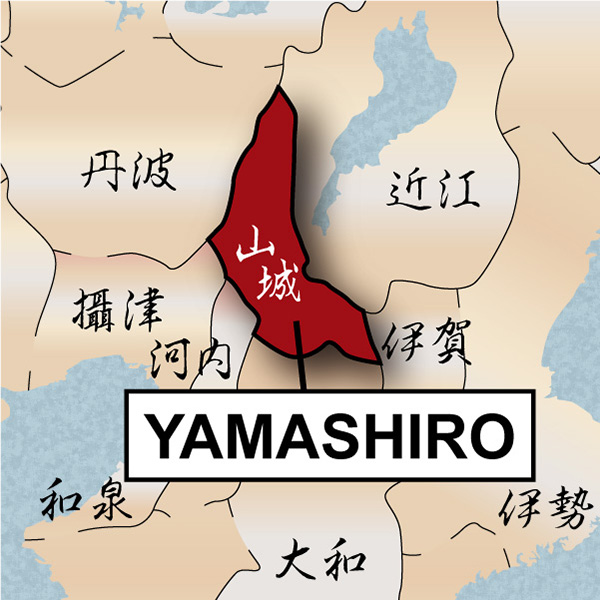
The first-gen Hisamichi received the honorable title of Omi No Kami(近江守) in 1662 when he was 37 years old. The emperor back then gave the title of Kami to those who were excellent at sword making. After receiving this title, the swordsmith added it to his maker’s name when he signed his swords, such as Omino Kami Hisamichi.
Hisamichi was also known as one of Gokaji. (five most prestigious swordsmiths in Kyoto). He was allowed to inscribe a chrysanthemum emblem, which is the symbol of the Japanese emperor. His sword forging technique was so great that the emperor permitted him to use this emblem, which was honorable for any swordsmith. A chrysanthemum emblem remains in the tang of this blade. The sword forged by him were also famous for their sharpness. He passed his excellent craftsmanship to the second-gen Hisamichi. And, he died at the age of 86 in 1711. Since the fourth generation, Hisamichi served Date clan in Iyo province and lasted until the early Meiji period.
This blade is appraised as a Hozon Touken (保存刀剣) issued by NBTHK (Nihon Bijutsu Touken Hozon Kyokai: 日本美術刀剣保存協会). This authentication paper was only given to authentic Japanese swords, well preserved and high quality with artistic value.
Please keep in mind that there are a couple of tiny Ktae Kizu on this blade. If you like to see the detailed condition before placing an order, please make sure to ask us to send you additional photos first.
【Blade】
Cutting Edge Length (Nagasa): 69.0 cm ( 27.1 inches)
Curvature (Sori): 1.24 cm (0.48 inches)

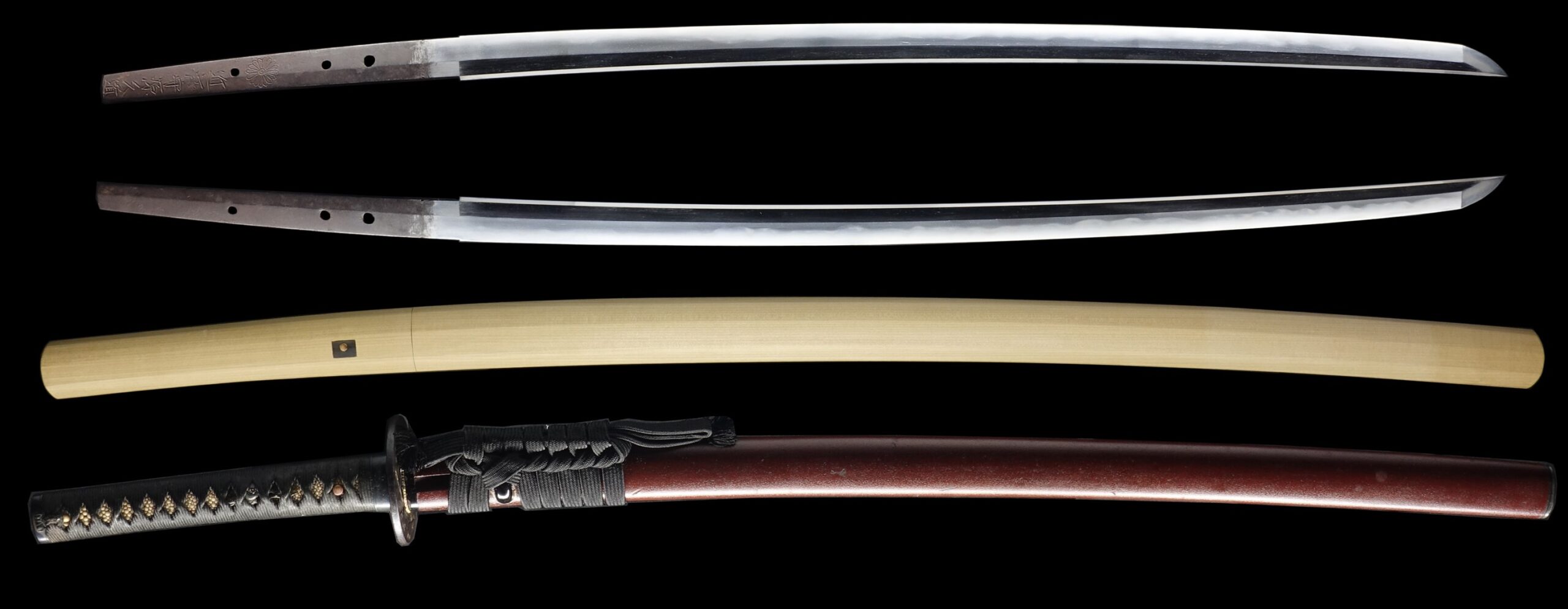
Hamon:
The crystalline structure which forms along the cutting edge of a blade as a result of the hardening process.
Jimon (Jihada):
Visible steel surface pattern created by folding and hammering during forging process.
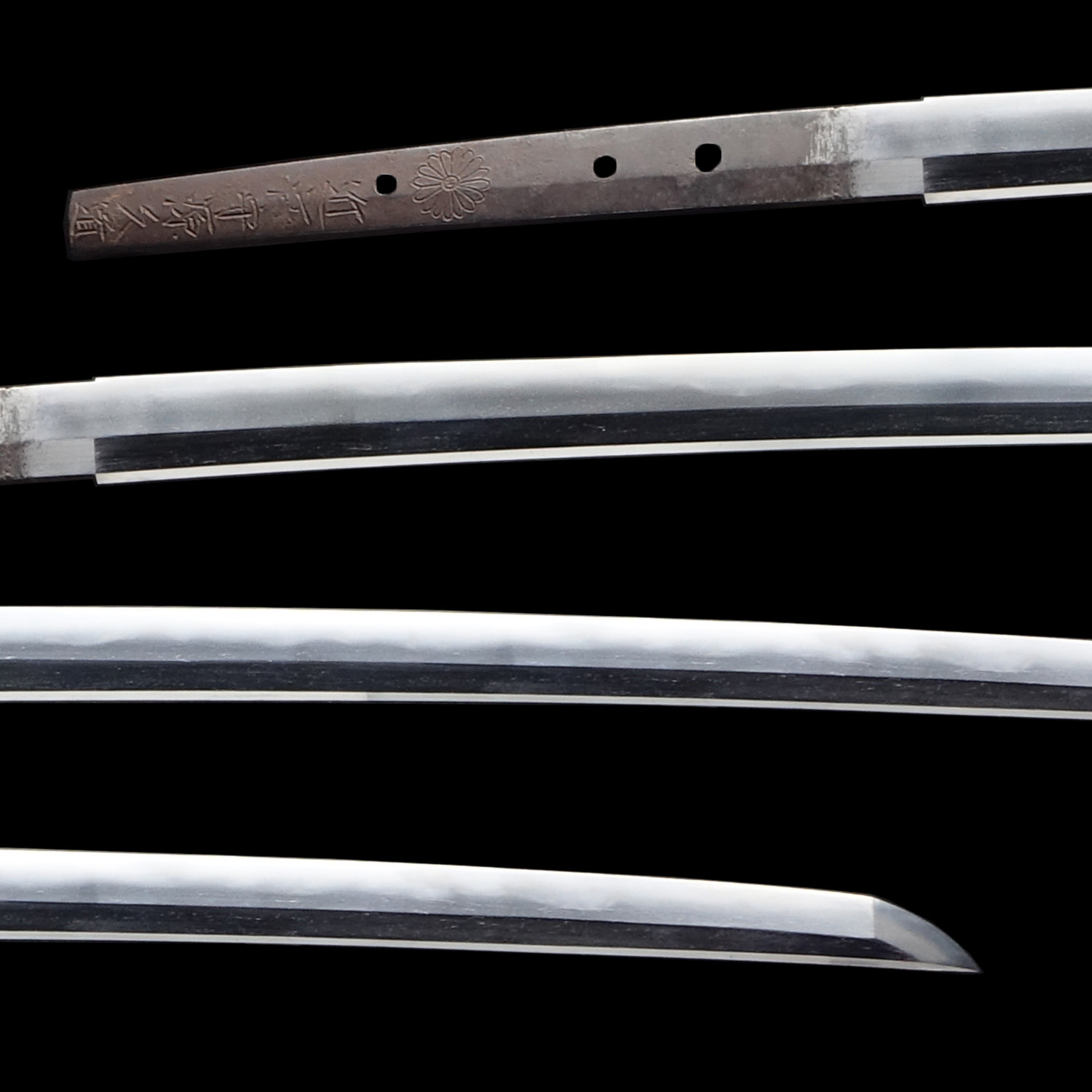
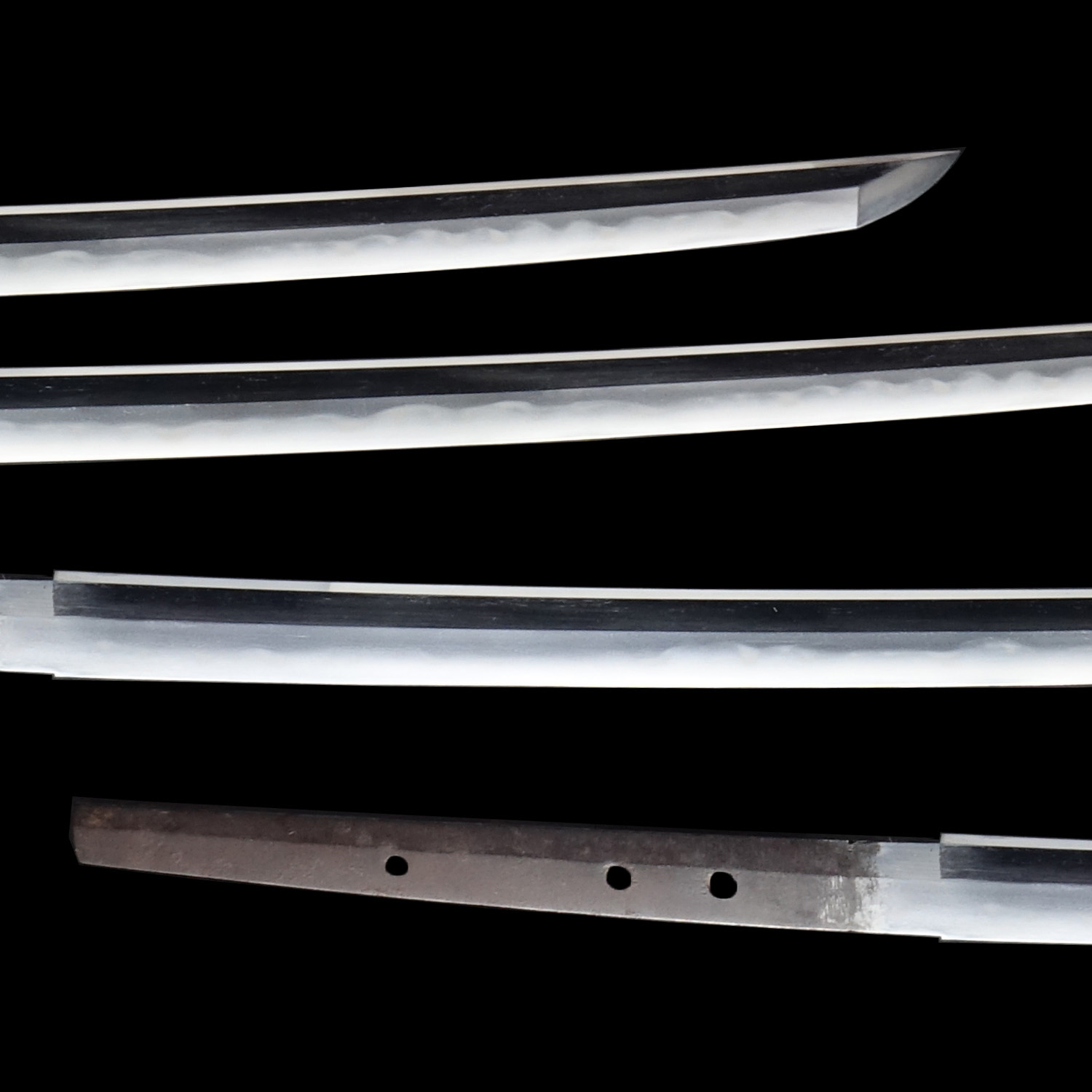
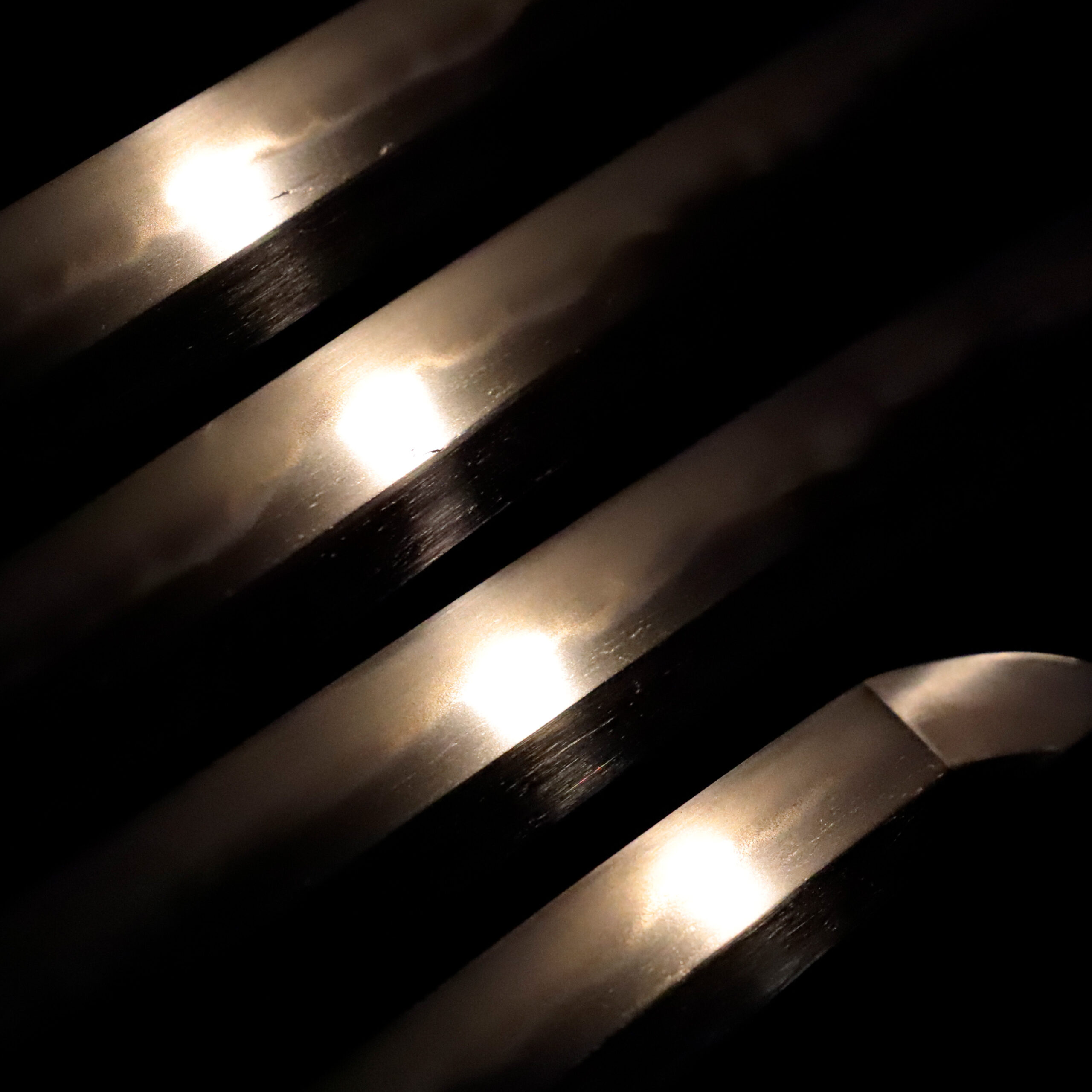
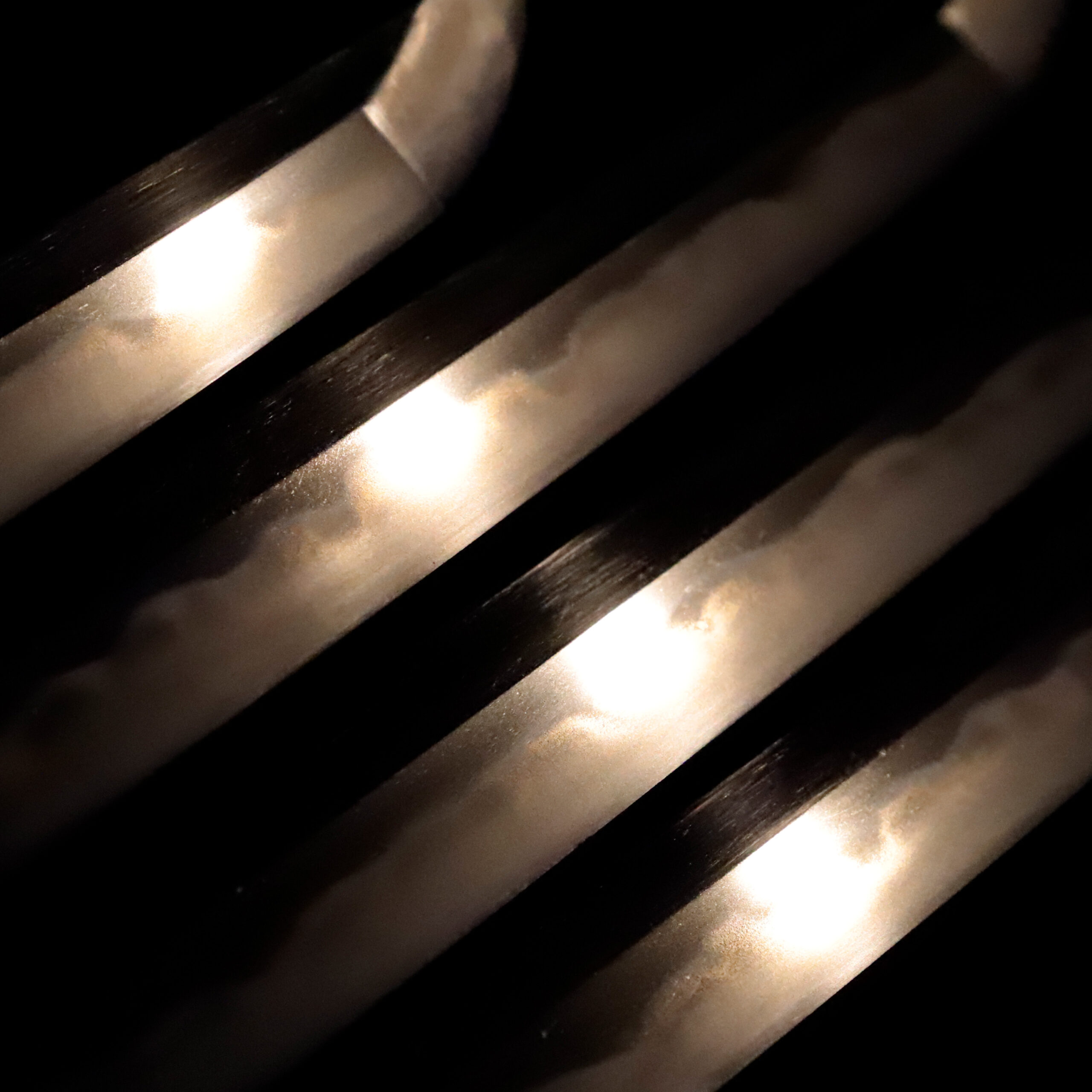
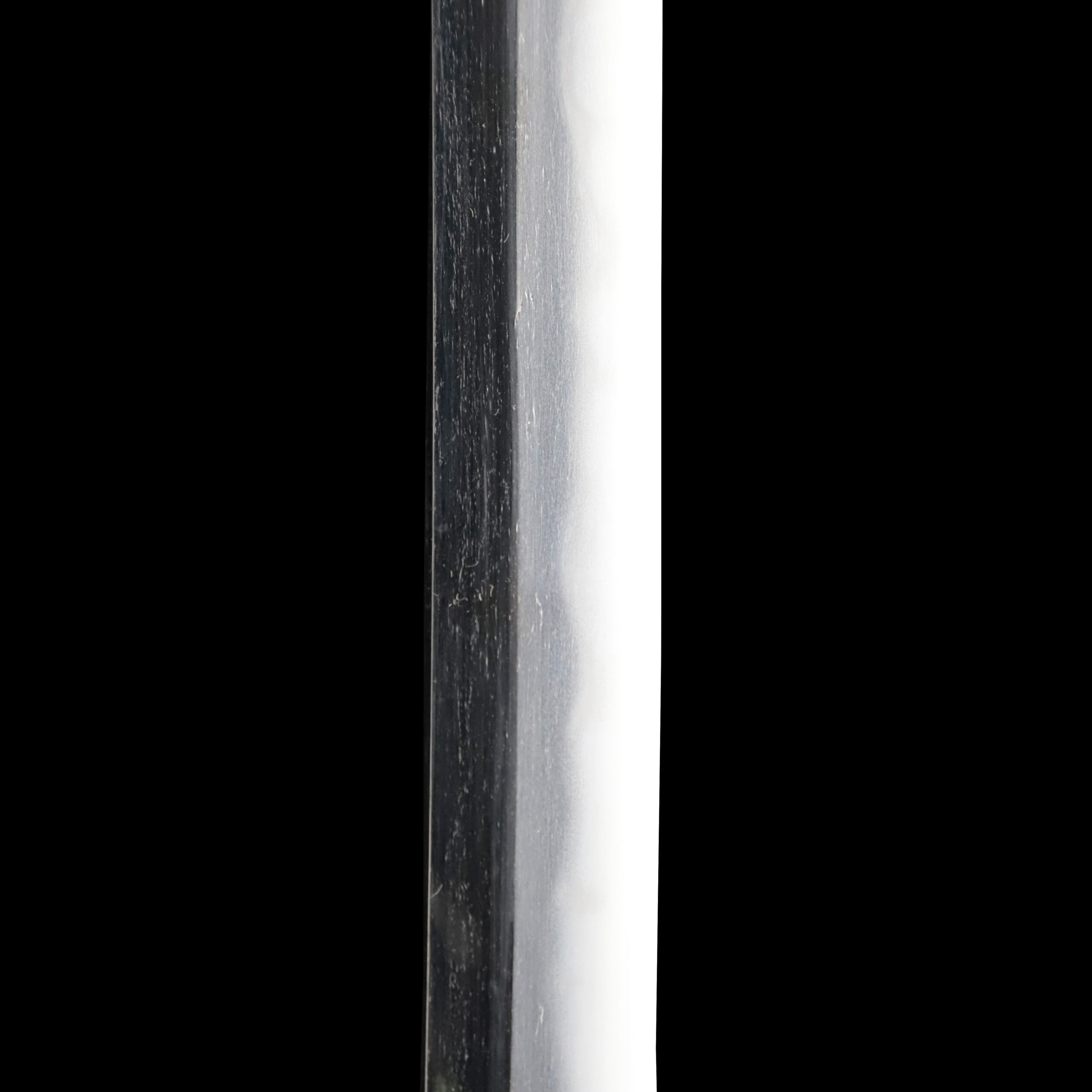
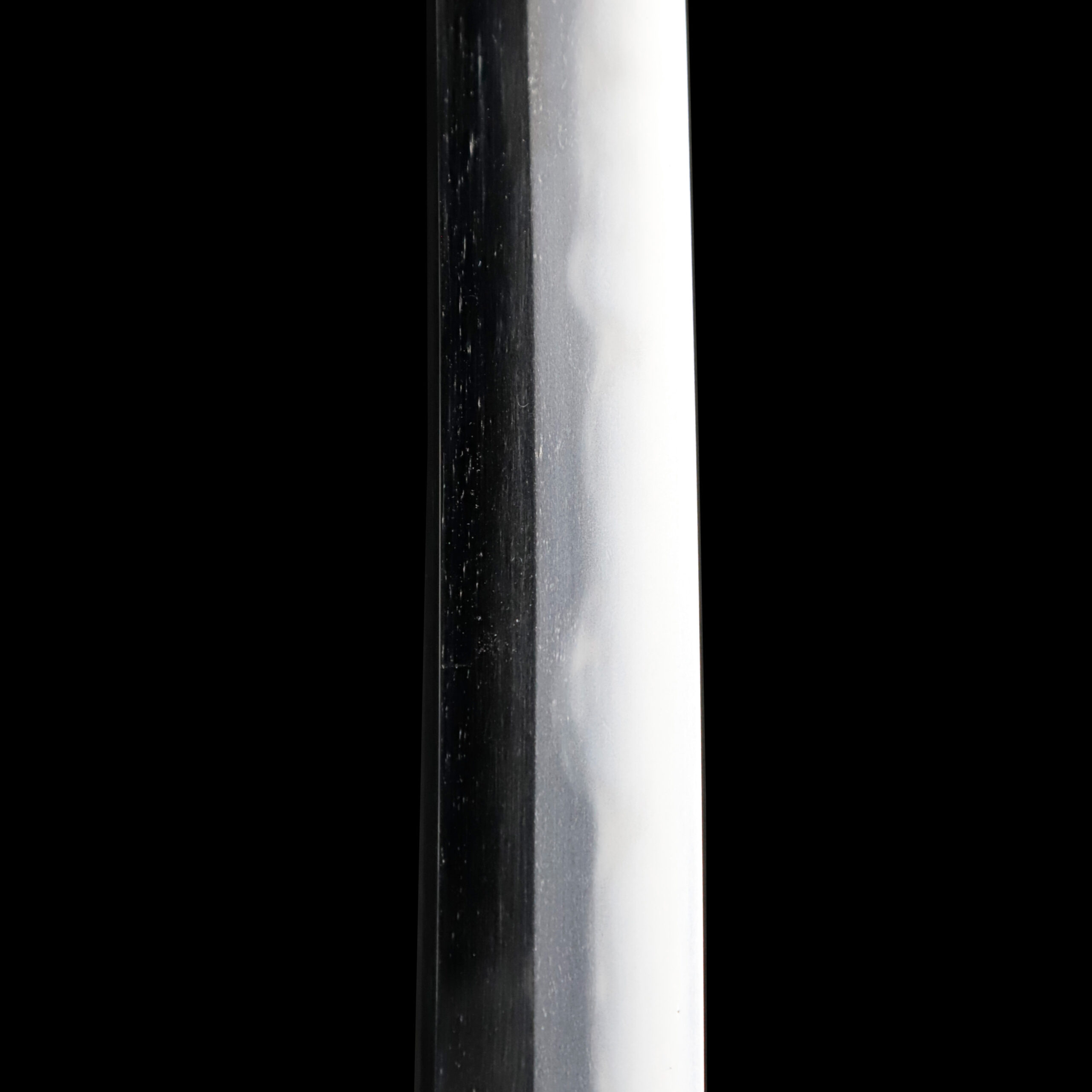
Kissaki: Kissaki is the tip of the Japanese sword.
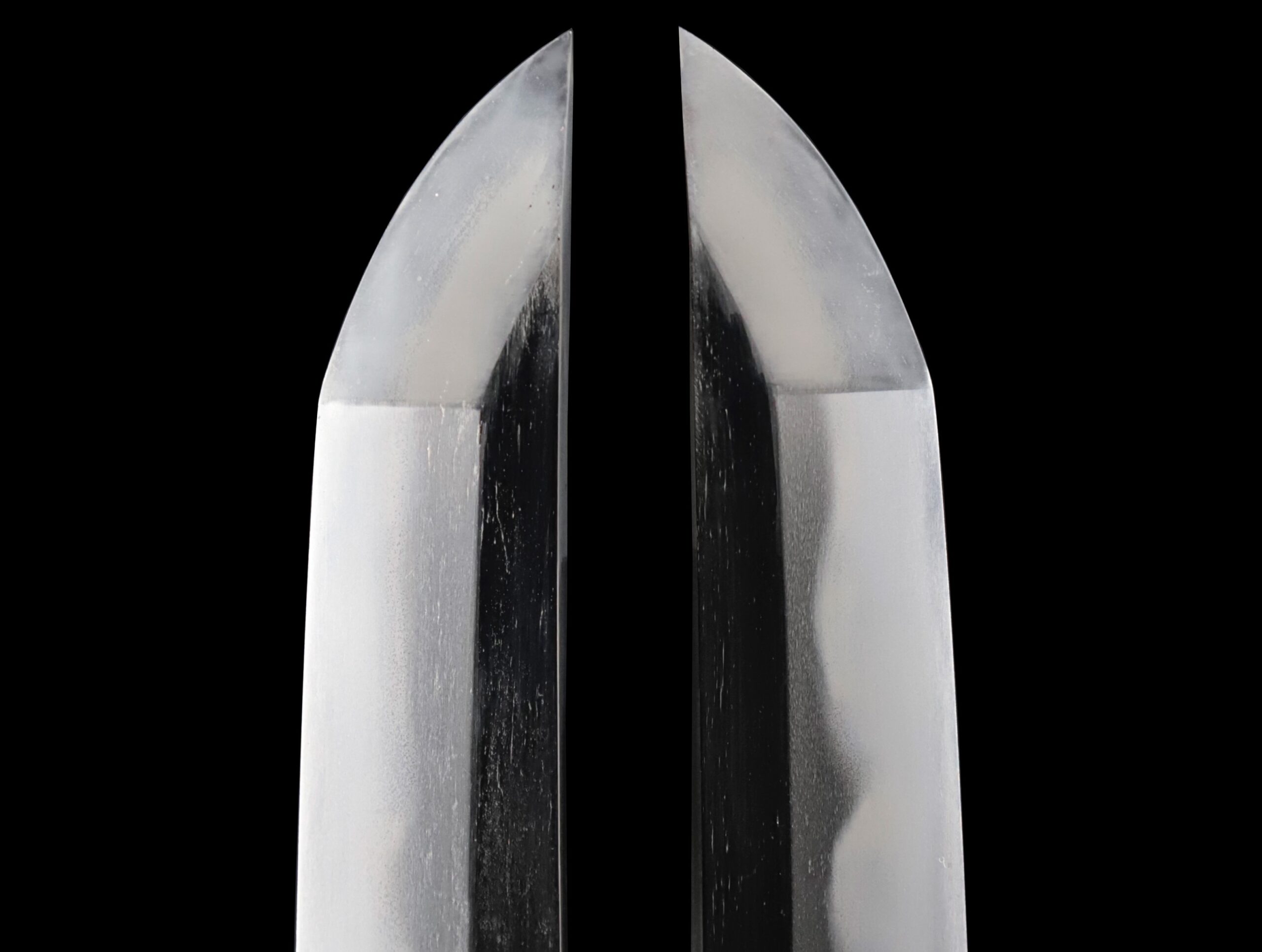
Nakago: Nakago is the tang of the Japanese sword.
Japanese swordsmiths left the black rust on the tang because it prevents red rust while the tang is in its handle. And the discoloration of the tang was created over time, and it is a great indicator for a Japanese sword specialist to estimate when the sword was forged.

Koshirae: Koshirae is the mounting of the Japanese sword. There are several parts that consist of Koshirae such as Saya (Scabbard), Tsuka (Handle), Tsuba (Handguard).
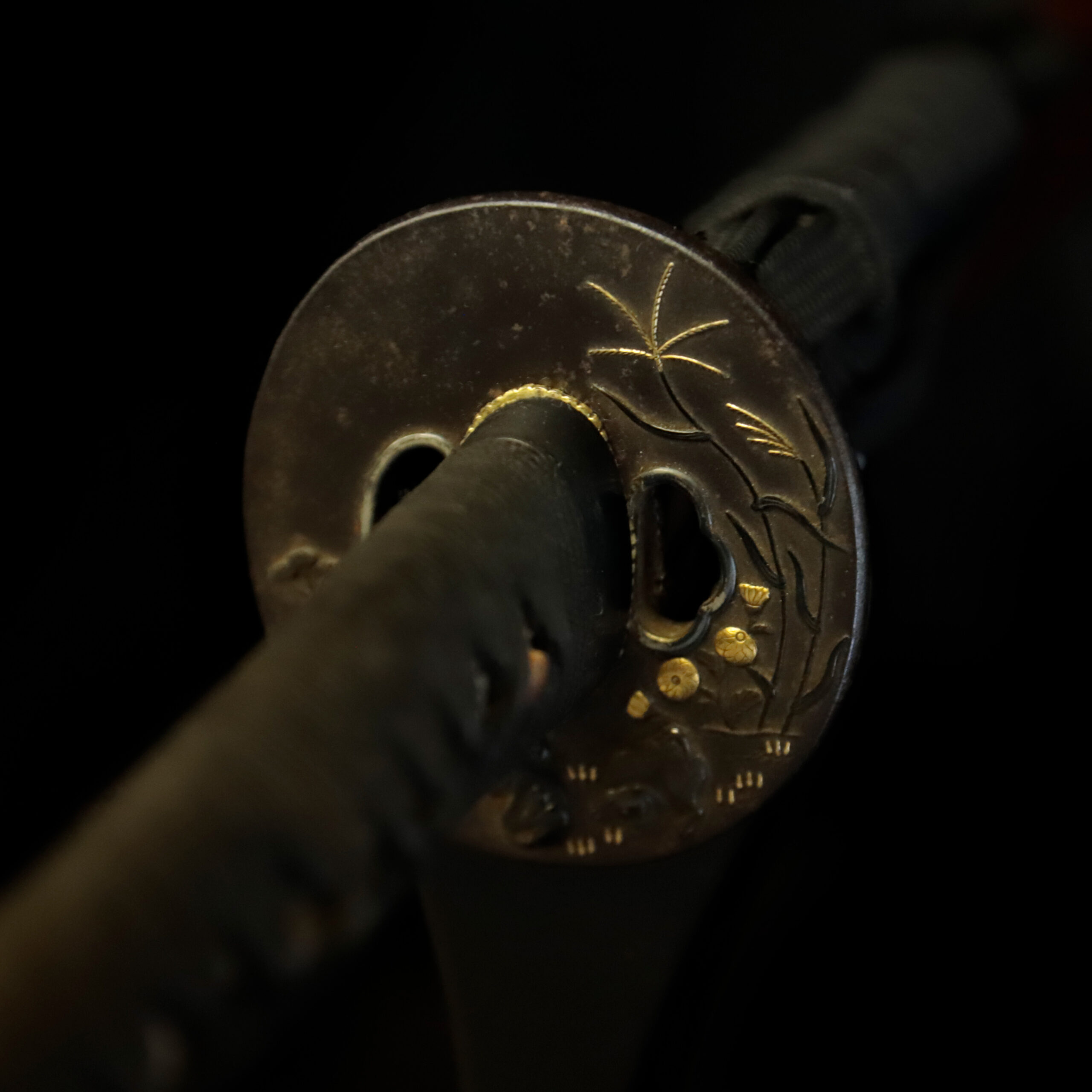
Fuchi-Kashira: A pair of matching sword fittings that cover the upper and bottom parts of its sword hilt.
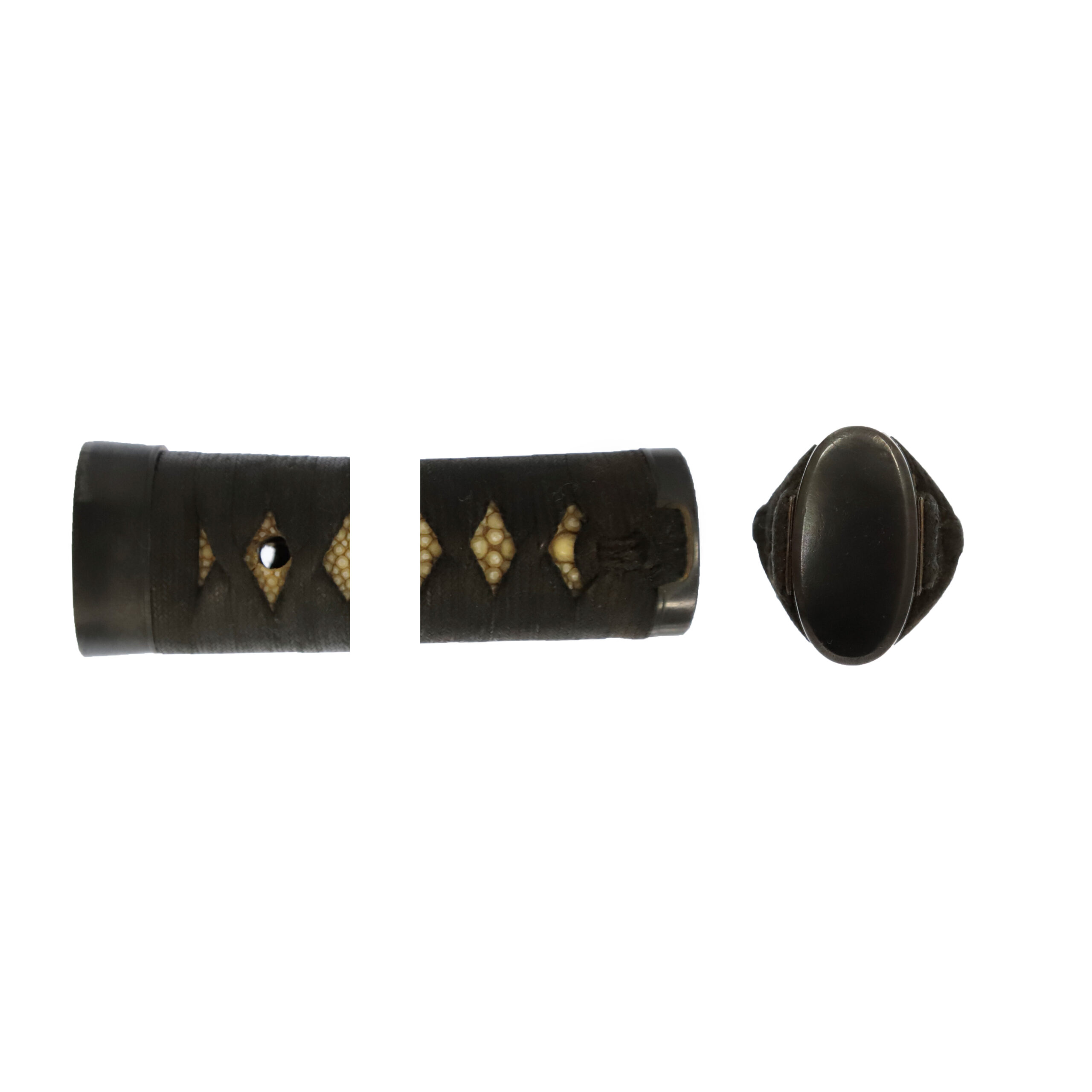
Tsuka and Menuki: Tsuka is the handle of the Japanese sword and Menuki is its decoration.
You would find the figure of a little bird perched on the branch. It seems this plant is a Japanese apricot tree. Golden paint is applied to each bird’s eyes. In Japan, there is a classical design that combines these motifs: Ume ni Uguisu (梅に鶯). It is a combination of Japanese apricot blossom and Japanese bush warbler. In Japanese poetries and paintings, it is a traditional analogy of a perfect match, a match made in heaven, or a good friendship.
There are several views about the origin of this word. According to a theory, this combination comes from the behavior of Japanese bush warblers. This bird likes the nectar of Japanese apricot blossoms, so it comes to a Japanese apricot tree and cries. However, it is actually the Mejiro (メジロ, Japanese white-eye) who prefers this nectar, not the Japanese bush warbler. Another theory says this combination was born because combining these motifs makes an elegant design. The bush warbler announces early spring with its beautiful cry. In addition, Japanese apricot blossoms bloom beautifully and announce the arrival of spring. It is the idea that this word was born because these combinations were thought to be an attractive design. In the first place, this subject is not native to Japan. It was brought from the continent; the same is true for Japanese apricot blossoms. It is said that nobles once began to use this theme out of their admiration for the continent.
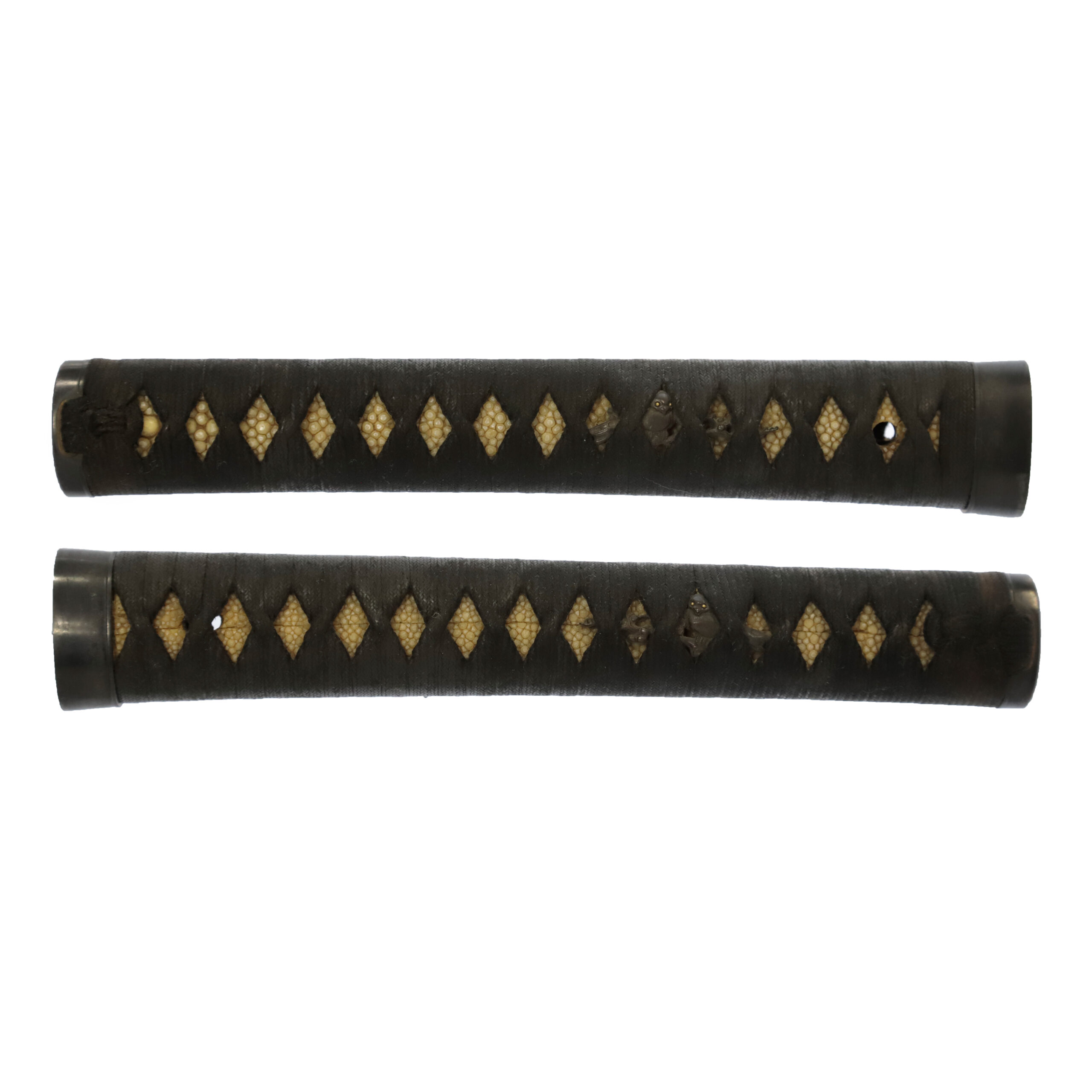
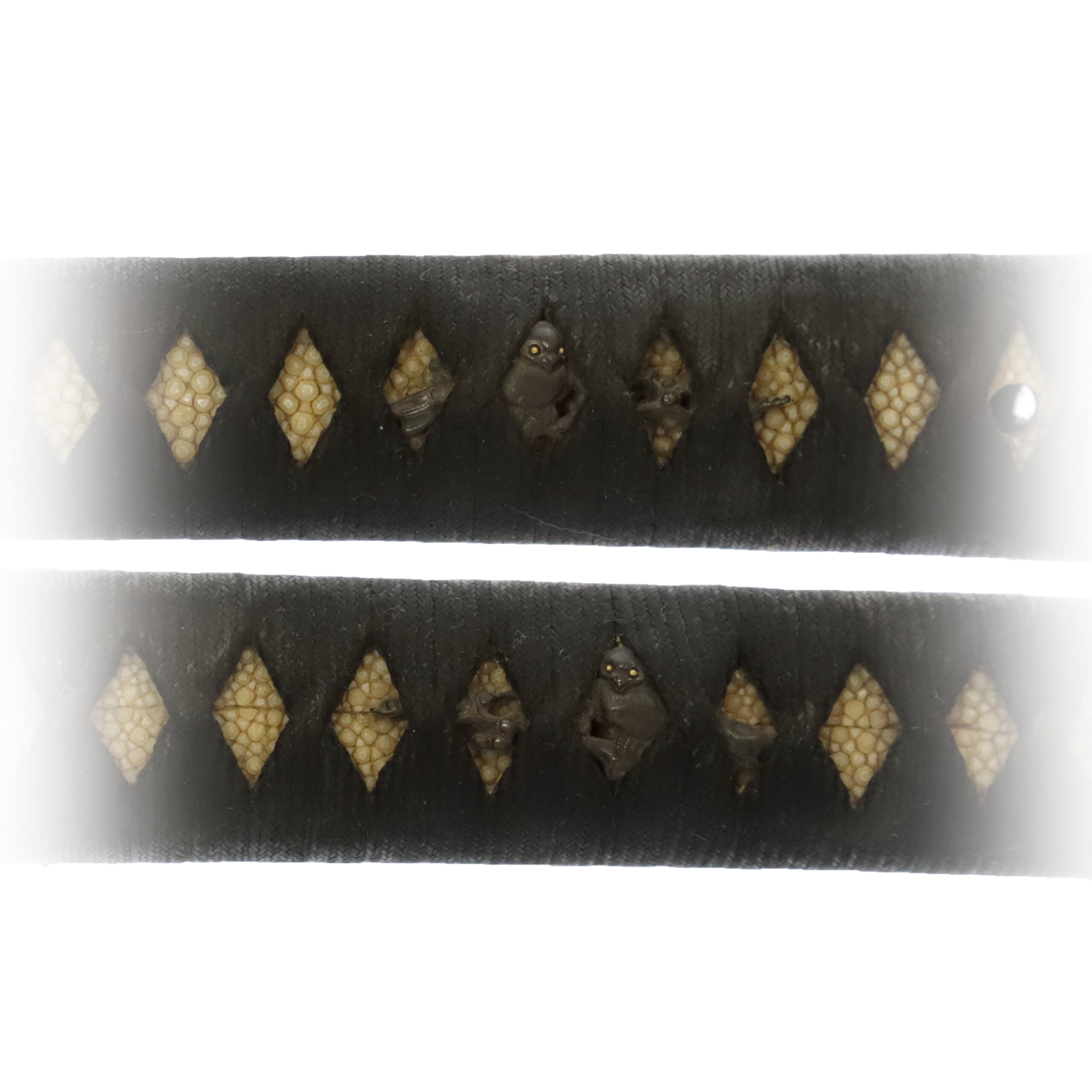
Tsuba and Habaki: Tsuba is the handguard for the Japanese Sword and Habaki is the equipment to make the blade not touch its scabbard inside. It prevents the blade from getting rusty and chipped.
This antique Tsuba has an oval shape. Kozuka and Kougai holes are framed with a silvery metal plate. About the design, the autumn scenery is depicted on this Tsuba. You could also see two puppies. Various plants are designed on this work: the Kiku (菊, chrysanthemum), Ominaeshi (女郎花, yellow patrinia), Obana (尾花, miscanthus sinensis), and Kikyou (桔梗, Japanese bellflower). Most of these plants are classified as Aki-no Nanakusa (秋の七草, the seven flowers of autumn). Here, we would like to focus on the Kikou pattern. This plant pattern has often been used as a motif of Tanka (短歌, a kind of traditional Japanese poem) and pictures since the Heian period (794-1185). Its name was initially “Kichikou,” but it changed to “Kikyou” over time. It is said this flower was used for fortune-telling in the old days. This action is called Kikkyou-wo Uranau (吉凶を占う) in Japanese. The word Kikkyou (吉凶, good or bad omen) was associated with this flower’s name. “Kichikou” was compared to the word “Kichi Kou (吉更),” which means further good fortune. That is why this flower pattern is treated as a good omen design. Another flower designed in this work is the Kiku (菊, chrysanthemum). A long time ago, chrysanthemums were used as medicine to obtain a long life on the continent, and they were brought to Japan with this thought in the Nara period (648-781). The chrysanthemum symbolizes fall, and people have greatly appreciated it since ancient times. The chrysanthemum has been likened to the sun as its petals form radially. That is why this flower pattern is treated as the symbol of perpetual youth and longevity or good health.
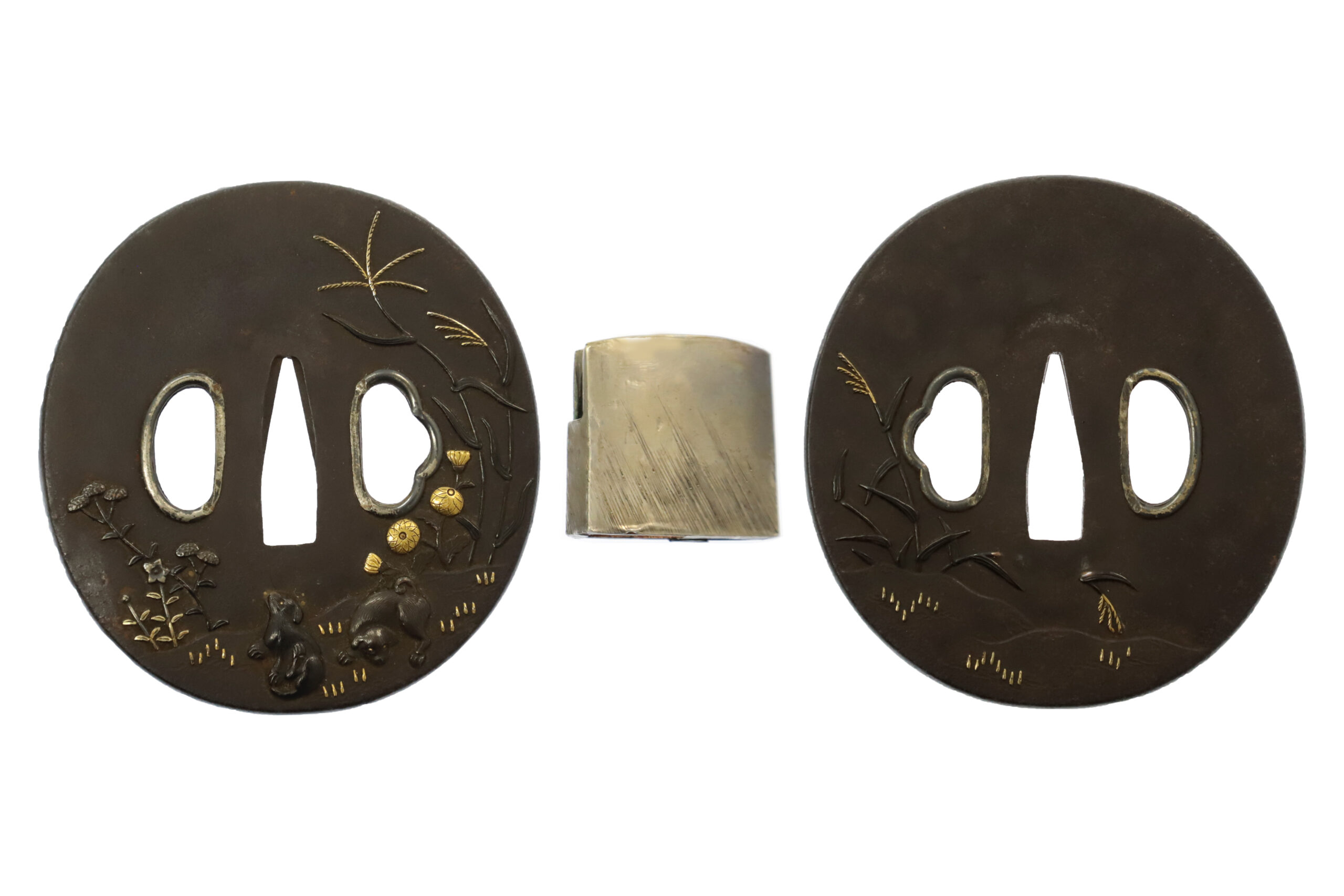
Saya: Saya is the scabbard for the Japanese sword.
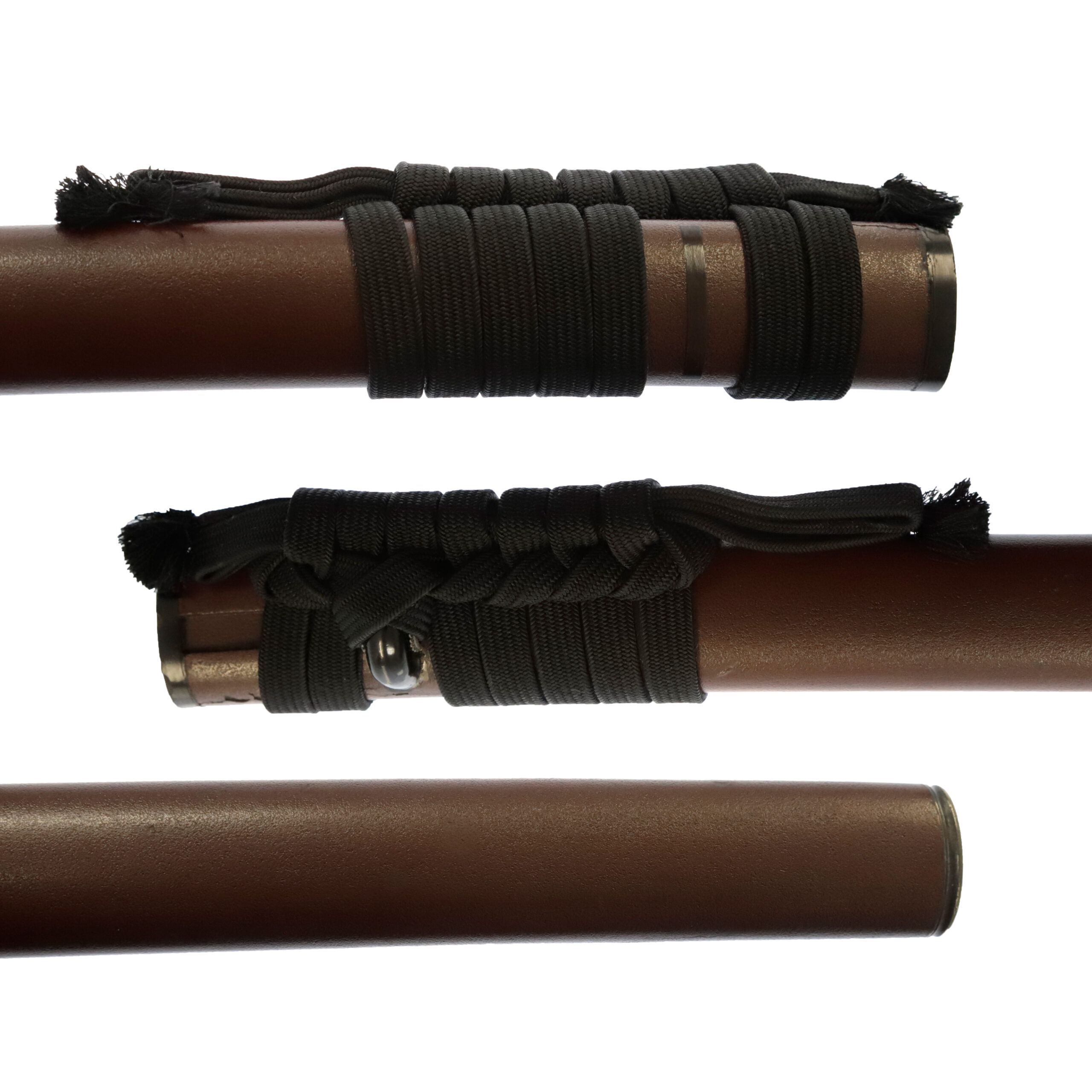
Authentication Paper: NBTHK Hozon Certificate for the blade (No.3032382)
NBTHK, also known as Nihon Bijutsu Touken Hozon Kyokai (the Society for the Preservation of the Japan Art Sword), is one of the oldest Japanese sword appraising organizations in modern-day Japan. They authenticated the blade on Aug 25th in the 5th year of Reiwa (2023). They appraised it as Hozon Touken, the blade worth preserving for Japanese society. The purchaser will receive this original certificate as well. We can also translate what is written into English and make a PDF file for your record if you request.
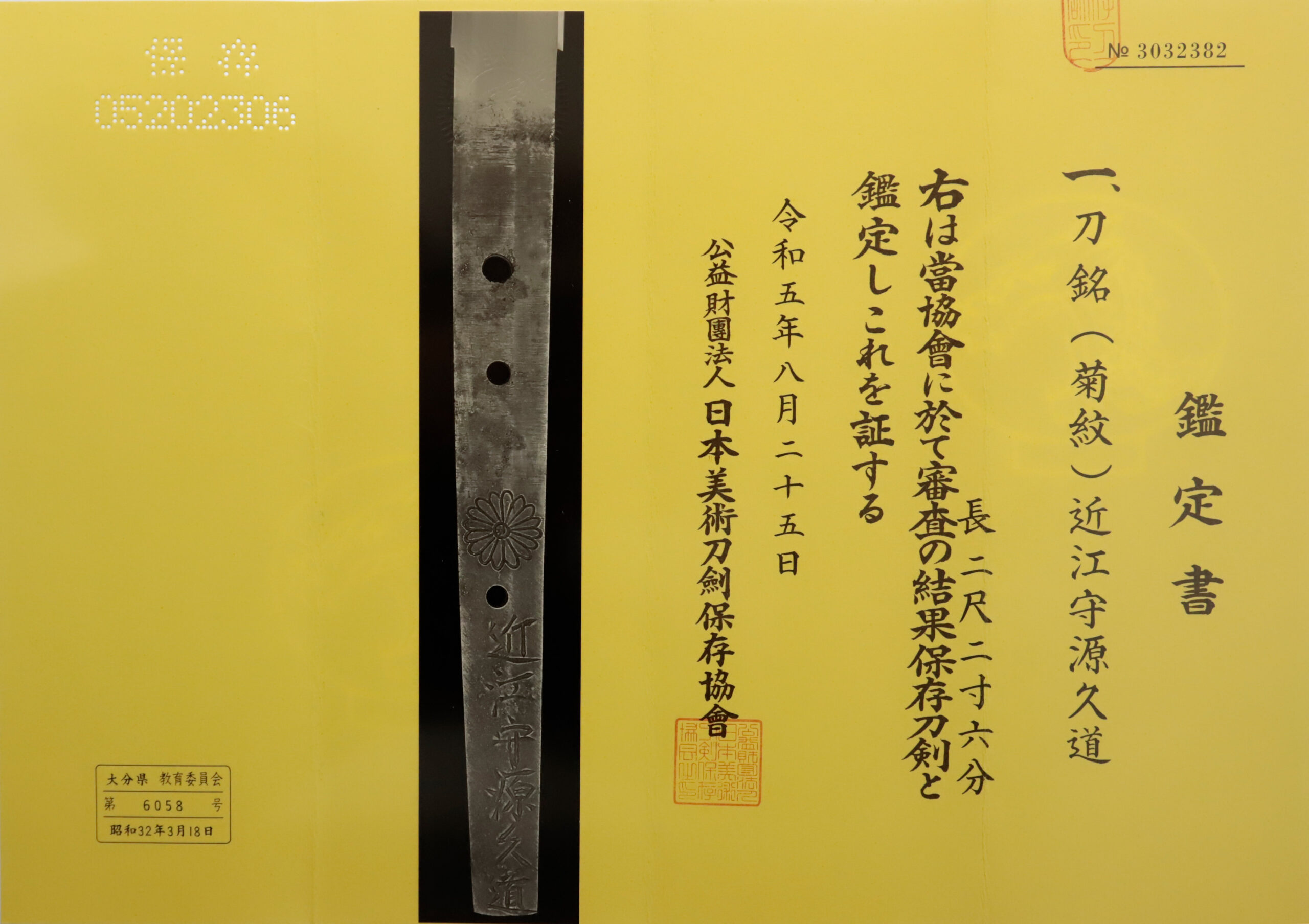
Registration Number: Oita 6058
The Board of Education in Oita prefecture issued a registration paper for this sword. It is called Jyu Token Rui Torokusho (銃刀剣類登録証). Bunkacho (The Agency for Cultural Affairs) acknowledges a Japanese sword with this paper as a work of art.
The sword needs to be traditionally hand-forged and made of Tamahagane carbon steel to be registered in the system. With this paper, its owner in Japan can legally own an authentic Japanese sword. Based on this registration number, we will apply for its export permit.
This paper will need to be returned to the board of education when the sword is being shipped abroad, but you can receive a copy of it. An English translation of this registration paper is available on request.
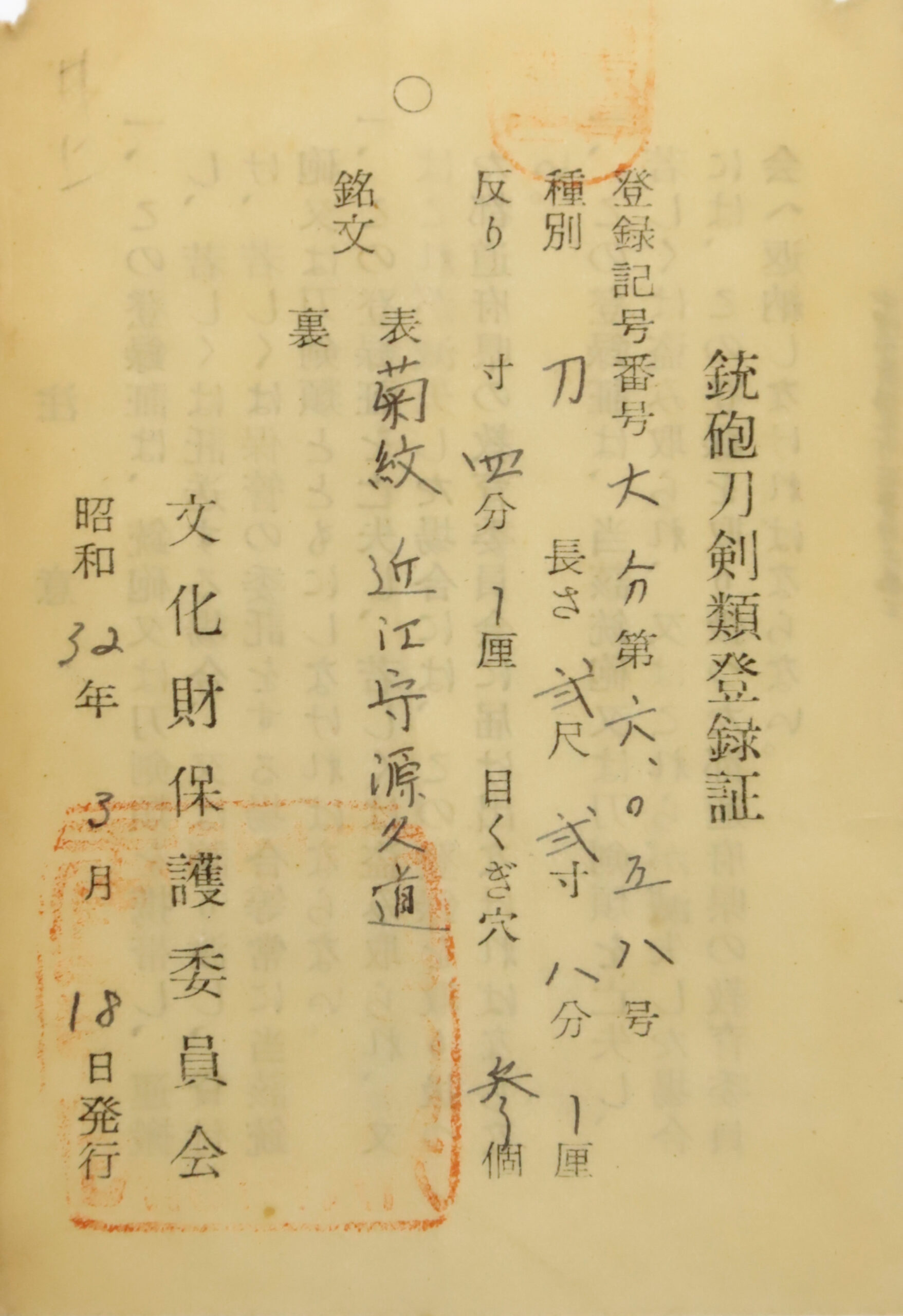

【About us】
Samurai Museum is located in Tokyo, Japan, exhibiting antique artifacts related to the Samurai history. Samurai Museum Shop is the place for those who are interested in Japanese culture and craftsmanship. We deal with antique Samurai swords/armor, traditional crafts made in Japan and so on.
【Japanese Sword& Export Process】
The Japanese swords we deal with are hand-forged edged swords made in Japan. It was made from the traditional carbon steel called TAMAHAGANE(玉鋼). Samurai Museum is familiar with the proper legal procedure for an antique/ authentic Japanese sword to be exported from Japan. We have sent more than 700 Japanese swords for the past few years (~2024) to amazing owners who appreciate its historical value.
Each Japanese sword is registered under the Agency for Cultural Affairs and the Board of Education in Japan. They issue a registration paper for each Japanese sword for its owner in Japan to legally possess it. The Japanese sword with its registration paper means it was traditionally hand-forged in Japan.
To legally export the sword from Japan to other countries, we will have to apply for its permit to the Agency for Cultural Affairs(Bunkacho) and return the original registration paper to the Board of Education. It normally takes around 2-4 weeks to receive this permit after submitting required documents. And we would like you to expect at least 1-1.5 months for your order to arrive at your given address after you ordered. For more detailed info, please click here.
It is allowed for residents in Japan to own authentic Japanese swords without a special license as long as they come with registration papers. Please feel free to contact us if you are a resident of Japan, whether temporarily or permanently. We will also assist you when you leave Japan and need to obtain the export permit.
【Payment Method】
We accept payment through Stripe (Credit card), PayPal, Apple Pay or ChromePay, all of which are secure payment methods. Also, you don’t need to make an account on Stripe for the checkout. If you prefer other payment method, please contact us. After confirming your payment, we will apply for an export permit. You may either pay in JPY, USD, AUD, CAD,EUR CHF or GBP. The price is set in Japanese Yen. Prices in other currencies are automatically calculated based on the latest exchange rate.

* If the amount is above 1 million JPY, Stripe or wire transfer will be the only options for payment.
【Shipping】
We have shipped authentic Japanese swords to the USA, UK, Canada, Mexico, Germany, France, Hong Kong, Finland and Australia. If you don’t live in these countries and like to order, please contact us first before making a purchase. We offer Free International Shipping as long as we can send antique Japanese swords by EMS.
We normally ship by EMS(Express Mail Service) provided by Japan Post. We will send you a tracking number for your order as soon as we hand it to the post office. We will put 100 % insurance on the shipping document without any extra charge. Based on the total amount, there might be a duty tax or other fee for you to pay, depending on the countries. We use package cushioning to protect the item and put it in a PVC pipe, which is one of the most secure packages because of its durability.
It will normally takes 5-14 days for the item to arrive at your given address after we dispatch it. Time of delivery is estimated as accurately as possible by the carrier but does not take into account any delays beyond our control such as by inclement weather, post office holiday seasons.
* If you live in Australia and like to purchase an authentic Japanese sword, please click here to know the detail.

【Review】
Here is one of the reviews we received from a customer who purchased an authentic Japanese sword from us. For more reviews, please click here.
“My experience overall with the whole process was wonderful. I had many questions about the history and process to purchase these treasures. All my questions were answered very timely and complete. The staff is very knowledgeable and very well versed if any questions do arise.”
【How to make sure the condition】
Please keep in mind that what you are going to purchase is an antique item. We uploaded high resolution photos for you to check its condition thoroughly. If you like to see more photos with different angles, please feel free to contact us. We will be happy to send them to you so that you can make informed decision. It is essential for us to know that you are happy with your choice of a sword. and we are prepared to use the best of our ability to serve you.
【How To Contact Us】
Please contact us through email, Facebook Messenger or Live Chat if you have any questions. You can find each icon on the right side of the website. Please click one of them to reach us. We will reply to you within 1-2 business days.
【The Art of Nihonto (Japanese Sword)】
Samurai’s history is a profound, eloquent legacy of ancient Japanese warriors in which millions of people worldwide are being fascinated. If you like to find out the art of Nihonto, please click here.
【A Guide to Japanese Sword Maintenance】
After acquiring an genuine Japanese sword, it is also important to know how to take good care of it. Here is the special video for you. Mr. Paul Martin, Japanese sword expert, shows you how to give proper maintenance to your sword. By mastering how to clean the Japanese sword, its aesthetic beauty will last forever.
When you purchase a Japanese sword from us, you can get a Free Japanese sword maintenance kit. It comes with four tools(Choji Oil, Uchiko Whetstone Powder, Peg remover, Oil Applicator). By watching the video instruction above , you can enjoy learning how to maintain your Japanese sword while appreciating it. If you have any difficulty assembling the sword or cleaning the blade, you can feel free to contact us.


MORE ANTIQUE JAPANESE SWORD FOR SALE
SWORDS WITHOUT CERTIFICATES FOR SALE
LEARN JAPANESE SWORD TERMINOLOGY
Thank you for reading all the information on the page. If you have any difficulty choosing the right Japanese sword for you, we will be more than happy to help you find the one that speaks to you the most. Please feel free to contact us.
